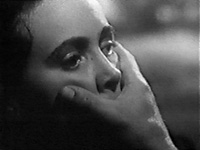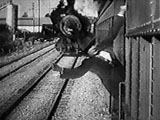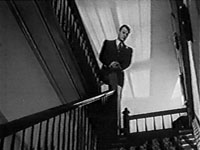Shadow Of A Doubt began life as the story "Uncle Charlie," by Gordon McDonell. Eventually, two very different specialists in American ways would be credited with work on the screenplay. Thornton Wilder, before enlisting in the Army, prepared the prose outline of the film. In many ways, Shadow Of A Doubt is the exact inverse of his paean to small-town life, the drama Our Town, for the film features the venality and the provincialism of the small town just as Our Town chose the companion virtues of simplicity and regionalism. After Wilder, Sally Benson, who was responsible for the stories on which the film Meet Me In St. Louis was based, (another, far more optimistic monument of wartime Americana) assisted in writing the dialogue.
 Yet the finished screenplay was Hitchcock's own, along with his faithful collaborator, his wife, Alma Reville. Hitchcock essentially acted as his own producer at Universal Pictures, then one of the smaller of the Hollywood dream factories. As a result, Hitchcock made few compromises in his careful examination of American life. As he wrote at the time:
Yet the finished screenplay was Hitchcock's own, along with his faithful collaborator, his wife, Alma Reville. Hitchcock essentially acted as his own producer at Universal Pictures, then one of the smaller of the Hollywood dream factories. As a result, Hitchcock made few compromises in his careful examination of American life. As he wrote at the time:
If possible I am extremely anxious to avoid the conventional small town American scene. By conventional I mean stock figures which have been seen in so many films of this type. I would like them to be very modern...by modern I mean that the small town should be influenced by movies, radio, juke boxes, etc.; in other words, as it were, life in a small town lit by neon signs.
 The only problem in the film's smooth production, which ran an efficient $813,000, was Hitchcock's failure to get Joan Fontaine for the leading role of young Charlie Newton. Eventually, he settled on Teresa Wright, who had understudied the part of Emily in Our Town on Broadway, and so knew her way around Wilder's small town as well as anyone. Wright recalls the association with undimmed appreciation: "He was the easiest of directors to work with." The rest of the film was as perfectly cast as any Hitchcock would ever make, including Joseph Cotten as a smooth, terrifying villain, productively cast against type. Hume Cronyn made his film debut in Shadow Of A Doubt as timid murder fancier Herb Hawkins; later, he would write the screenplays for two of Hitchcock's films. And Patricia Collinge, as Emma Newton, sounded a note of tremulous, dull-witted motherlove which belied the actress' own intelligence; she wrote many of her character's long speeches, one of the few times in Hitchcock's career an actress was allowed this freedom.
The only problem in the film's smooth production, which ran an efficient $813,000, was Hitchcock's failure to get Joan Fontaine for the leading role of young Charlie Newton. Eventually, he settled on Teresa Wright, who had understudied the part of Emily in Our Town on Broadway, and so knew her way around Wilder's small town as well as anyone. Wright recalls the association with undimmed appreciation: "He was the easiest of directors to work with." The rest of the film was as perfectly cast as any Hitchcock would ever make, including Joseph Cotten as a smooth, terrifying villain, productively cast against type. Hume Cronyn made his film debut in Shadow Of A Doubt as timid murder fancier Herb Hawkins; later, he would write the screenplays for two of Hitchcock's films. And Patricia Collinge, as Emma Newton, sounded a note of tremulous, dull-witted motherlove which belied the actress' own intelligence; she wrote many of her character's long speeches, one of the few times in Hitchcock's career an actress was allowed this freedom.
Cinematographer Joseph Valentine filmed the streets of Santa Rosa, California with documentary clarity; the town was used that same year for another drama of the American small town, The Happy Land. Art director Robert Boyle built the interior of the Newtons' rambling Victorian house on Universal's Stage 22 under deliberate instructions from Hitchcock to make the structure amenable to camera set-ups and movement. ("No director I've worked with knew as much about films as he did," said Boyle, "He was always trying to make the visual statement, and there was no such thing as the throwaway shot.") The house was literally designed around the shots Hitchcock wanted to get inside it, the walls, windows, porch and roof swinging silently away in front of the moving camera. As a result, we get as clear a sense of the floorplan of the Newton home as any in American cinema.
 It's easy to imagine ourselves wandering its wide, dark, upstairs halls, and just as easy to imagine being stalked by the frightening Uncle Charlie. Hitchcock made the home a place where exotic terror lives uneasily with domesticity, an innovation he remembered when he returned to the Universal lot many years later to build the more famous Bates house for Psycho.
It's easy to imagine ourselves wandering its wide, dark, upstairs halls, and just as easy to imagine being stalked by the frightening Uncle Charlie. Hitchcock made the home a place where exotic terror lives uneasily with domesticity, an innovation he remembered when he returned to the Universal lot many years later to build the more famous Bates house for Psycho.
Hitchcock's Santa Rosa was instantly recognizable as the quintessential American town of the 1940's. Yet in Shadow Of A Doubt, the bizarre and the fantastic seem by the end of the film to shriek at us, slaughtering everything prosaic in Santa Rosa. In his memorable speech to young Charlie in the 'Til Two club, Uncle Charlie reveals his awful vision of "what you'd find if you ripped the fronts off the houses" on Santa Rosa's tree-shaded streets. And as the film ends, young Charlie, and the audience in the theater, both shaken, are left with Uncle Charlie's grim, self-spoken memorial:
You wake up every morning of your life and you know perfectly well that there's nothing in the world to trouble you. You go through your ordinary little day and at night you sleep your untroubled, ordinary little sleep filled with peaceful, stupid dreams. And I brought you nightmares...

 1943's Shadow Of A Doubt, however, was Hitchcock's first fully realized cinema masterpiece, a grim, sad picture of American docility and Babbittry. The film moved Hitchcock out of the category of mere genre director and into the realm of the essayist on the universal fears and discontents of his species. In the process, Shadow Of A Doubt slanders that most cherished of American landscapes, the small town. That such a thorough critique of American mores appeared during World War II, a time when other directors were enshrining rather than embalming these standards, seems nothing short of incredible.
1943's Shadow Of A Doubt, however, was Hitchcock's first fully realized cinema masterpiece, a grim, sad picture of American docility and Babbittry. The film moved Hitchcock out of the category of mere genre director and into the realm of the essayist on the universal fears and discontents of his species. In the process, Shadow Of A Doubt slanders that most cherished of American landscapes, the small town. That such a thorough critique of American mores appeared during World War II, a time when other directors were enshrining rather than embalming these standards, seems nothing short of incredible.

 Yet the finished screenplay was Hitchcock's own, along with his faithful collaborator, his wife, Alma Reville. Hitchcock essentially acted as his own producer at Universal Pictures, then one of the smaller of the Hollywood dream factories. As a result, Hitchcock made few compromises in his careful examination of American life. As he wrote at the time:
Yet the finished screenplay was Hitchcock's own, along with his faithful collaborator, his wife, Alma Reville. Hitchcock essentially acted as his own producer at Universal Pictures, then one of the smaller of the Hollywood dream factories. As a result, Hitchcock made few compromises in his careful examination of American life. As he wrote at the time:
 The only problem in the film's smooth production, which ran an efficient $813,000, was Hitchcock's failure to get Joan Fontaine for the leading role of young Charlie Newton. Eventually, he settled on Teresa Wright, who had understudied the part of Emily in Our Town on Broadway, and so knew her way around Wilder's small town as well as anyone. Wright recalls the association with undimmed appreciation: "He was the easiest of directors to work with." The rest of the film was as perfectly cast as any Hitchcock would ever make, including Joseph Cotten as a smooth, terrifying villain, productively cast against type. Hume Cronyn made his film debut in Shadow Of A Doubt as timid murder fancier Herb Hawkins; later, he would write the screenplays for two of Hitchcock's films. And Patricia Collinge, as Emma Newton, sounded a note of tremulous, dull-witted motherlove which belied the actress' own intelligence; she wrote many of her character's long speeches, one of the few times in Hitchcock's career an actress was allowed this freedom.
The only problem in the film's smooth production, which ran an efficient $813,000, was Hitchcock's failure to get Joan Fontaine for the leading role of young Charlie Newton. Eventually, he settled on Teresa Wright, who had understudied the part of Emily in Our Town on Broadway, and so knew her way around Wilder's small town as well as anyone. Wright recalls the association with undimmed appreciation: "He was the easiest of directors to work with." The rest of the film was as perfectly cast as any Hitchcock would ever make, including Joseph Cotten as a smooth, terrifying villain, productively cast against type. Hume Cronyn made his film debut in Shadow Of A Doubt as timid murder fancier Herb Hawkins; later, he would write the screenplays for two of Hitchcock's films. And Patricia Collinge, as Emma Newton, sounded a note of tremulous, dull-witted motherlove which belied the actress' own intelligence; she wrote many of her character's long speeches, one of the few times in Hitchcock's career an actress was allowed this freedom.
 It's easy to imagine ourselves wandering its wide, dark, upstairs halls, and just as easy to imagine being stalked by the frightening Uncle Charlie. Hitchcock made the home a place where exotic terror lives uneasily with domesticity, an innovation he remembered when he returned to the Universal lot many years later to build the more famous Bates house for Psycho.
It's easy to imagine ourselves wandering its wide, dark, upstairs halls, and just as easy to imagine being stalked by the frightening Uncle Charlie. Hitchcock made the home a place where exotic terror lives uneasily with domesticity, an innovation he remembered when he returned to the Universal lot many years later to build the more famous Bates house for Psycho.